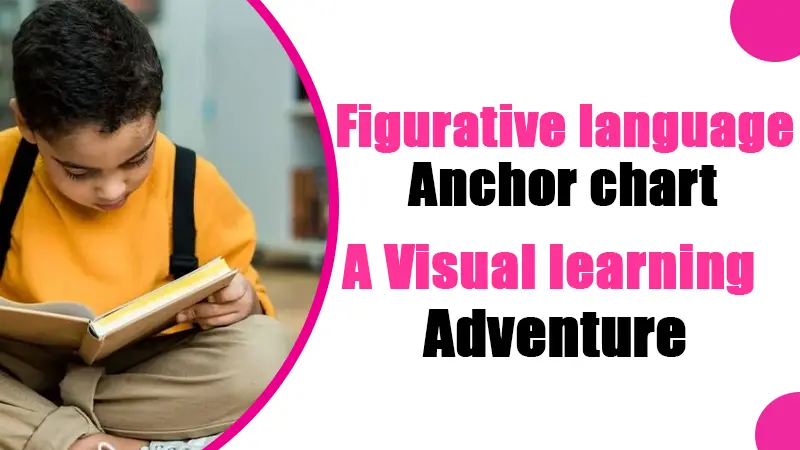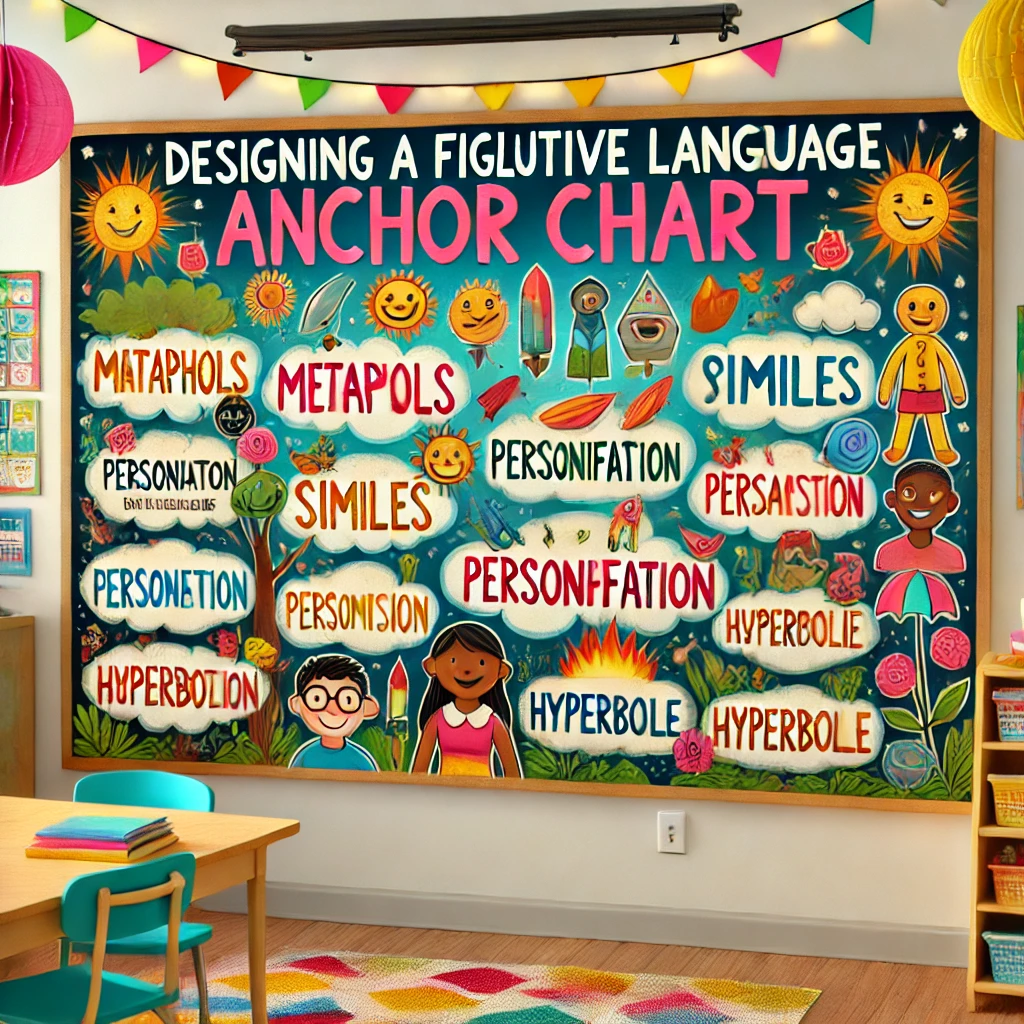
Figurative language is the colorful tapestry of words that paints vivid pictures in our minds which plays a pivotal role in language arts education. Far beyond mere words on a page, figurative language infuses literature with depth, emotion, and complexities, enriching our understanding and appreciation of the written word.
In the journey of literacy development, understanding figurative language is akin to unlocking a treasure trove of linguistic creativity and expression. In classroom instruction, educators continually seek innovative tools and strategies to illuminate complex concepts and engage students in active learning.
Anchored firmly on classroom walls or easels, these charts serve as constant reminders of key concepts and provide a shared reference point for exploration and discussion. Let’s explore the symbiotic relationship between figurative language and anchor charts.
What is a Figurative Language Anchor Chart?
A figurative language anchor chart is a visual tool used in educational settings to illustrate and explain various forms of figurative language, such as similes, metaphors, personification, and idioms.
It typically features examples, definitions, and visual representations of each type of figurative language, serving as a reference point for students to deepen their understanding of literary devices.
Significance in Literature and Communication
Facilitates Understanding: Figurative language anchor charts provide students with clear explanations and examples of abstract concepts, making it easier for them to grasp the nuances of language and literary expression.
Promotes Analysis: By visually organizing different types of figurative language, anchor charts encourage students to analyze texts more critically, identifying figurative language elements and exploring their effects on meaning and tone.
Supports Writing Skills: Understanding figurative language is essential for effective communication in writing. Anchor charts serve as a resource for students to incorporate figurative language into their own writing, enhancing creativity and expression.
Fosters Discussion: Anchor charts stimulate classroom discussions about language use in literature, allowing students to share interpretations, analyze examples, and collaborate in understanding complex literary concepts.
Cultivates Appreciation: By highlighting the beauty and power of figurative language, anchor charts cultivate an appreciation for the richness of language and its role in literature and communication.
Overall, figurative language anchor charts serve as valuable tools for educators to scaffold students’ learning, promote critical thinking, and foster a deeper appreciation for the artistry of language in both literature and communication.
Designing a Figurative Language Anchor Chart
Creating a figurative language anchor chart involves thoughtful design and organization to ensure it effectively communicates key concepts while engaging students visually.
Here are some tips and suggestions for crafting an informative and visually appealing anchor chart:
1. Clear Title and Headers:
Begin with a bold, clear title that clearly indicates the purpose of the anchor chart, such as “Exploring Figurative Language” or “Figurative Language Toolbox.”
Use headers and subheaders to organize content into distinct sections, making it easy for students to navigate and understand.
2. Visual Elements:
Incorporate visual elements such as illustrations, icons, or color-coded examples to enhance comprehension and engagement.
Utilize images that represent each type of figurative language, helping students make connections between words and visual concepts.
3. Consistent Formatting:
Maintain consistency in font style, size, and color throughout the anchor chart to create a cohesive look.
Use bullet points, numbering, or columns to organize information neatly and prevent clutter.
4. Examples and Explanations:
Provide clear and concise examples of each type of figurative language, accompanied by brief explanations or definitions.
Use real-world examples from literature, poetry, or everyday language to illustrate how figurative language is used in context.
5. Interactive Components:
Include interactive elements such as flaps, tabs, or sticky notes that students can lift or move to reveal additional information or examples.
Encourage student participation by inviting them to add their own examples or annotations to the anchor chart.
6. Space for Student Contributions:
Reserve space on the anchor chart for students to contribute their own examples of figurative language or insights gained from discussions and activities.
Incorporate collaborative elements that encourage peer interaction and shared learning experiences.
7. Review and Revision:
Regularly review and update the anchor chart to reflect students’ growing understanding of figurative language and any new examples or insights discovered.
Encourage students to take ownership of the anchor chart by allowing them to participate in its creation and revision process.
Examples of Figurative Language Anchor Charts
Figurative language adds spice to writing, making it more vivid and engaging. Anchor charts can be valuable tools for students to grasp these concepts. Let’s explore some examples, analyzing their strengths and potential improvements, and even suggesting interactive activities:
1. Colorful and Clear:
Colorful Figurative Language Anchor Chart from Pinterest
Strengths:
- Visually appealing with bright colors and engaging fonts.
- Clear definitions for each term (simile, metaphor, hyperbole, etc.).
- Simple examples make it easy for young learners to understand.
Improvements:
- Could add more complex examples for older students.
- Include student-generated examples to encourage participation.
Interactive Activity:
- Have students create their own miniature anchor charts focusing on a specific term.
- Play a “Guess the Figure” game where students act out metaphors or similes for others to guess.
2. Venn Diagram for Simile and Metaphor:
Strengths:
- Venn diagram effectively shows overlaps and differences between simile and metaphor.
- Uses clear and concise definitions.
- Includes helpful icons to reinforce understanding.
Improvements:
- Could expand to include other figurative language devices.
- Consider adding more examples within each section of the Venn diagram.
Interactive Activity:
- Sort literary quotes into the Venn diagram sections based on whether they are similes, metaphors, or neither.
- Challenge students to create their own Venn diagrams comparing other figurative language terms.
3. Interactive “SHAMPOO” Chart:
SHAMPOO Figurative Language Anchor Chart from WeAreTeachers
Strengths:
- Memorable “SHAMPOO” acronym for simile, hyperbole, alliteration, metaphor, personification, and onomatopoeia.
- Interactive elements like flaps to reveal definitions and examples.
- Engaging design captures students’ attention.
Improvements:
- Limited space might restrict the number of examples.
- Consider including additional figurative language devices.
Interactive Activity:
- Use the flaps to play a memory game, matching definitions to terms.
- Have students add their own examples and illustrations under each flap.
Interactive Activities with Anchor Charts
Integrating figurative language anchor charts into classroom instruction can enhance literacy skills and promote a deeper understanding of language use in literature and communication. By following these strategies, educators can effectively incorporate anchor charts into lesson plans and create meaningful learning experiences for students.
- Begin by introducing the concept of figurative language and anchor charts.
- Provide explicit instruction on each type of figurative language featured on the anchor chart.
- Scaffold student learning by guiding them through interactive activities.
- Encourage students to independently apply their understanding of figurative language in their reading, writing, and discussions, referring to the anchor chart as a resource.
- Incorporate regular opportunities for reflection and review,
Differentiate instruction to meet the diverse needs of learners, providing additional support or challenge as necessary to ensure all students can engage effectively with the anchor chart and related activities.
Closing Remarks
Figurative language anchor charts serve as invaluable tools for both educators and students alike. Through their visual appeal and informative content, these charts illuminate the intricacies of figurative language, fostering a deeper understanding and appreciation of language use in literature and communication.
By integrating interactive activities and thoughtful implementation strategies, educators can harness the power of anchor charts to engage students in meaningful learning experiences and cultivate essential literacy skills.

